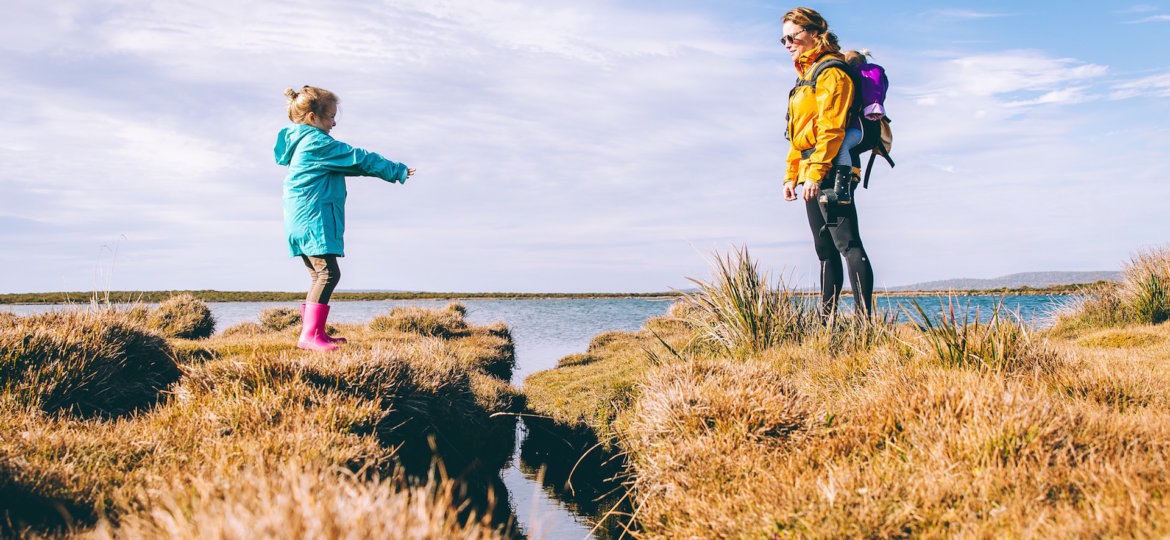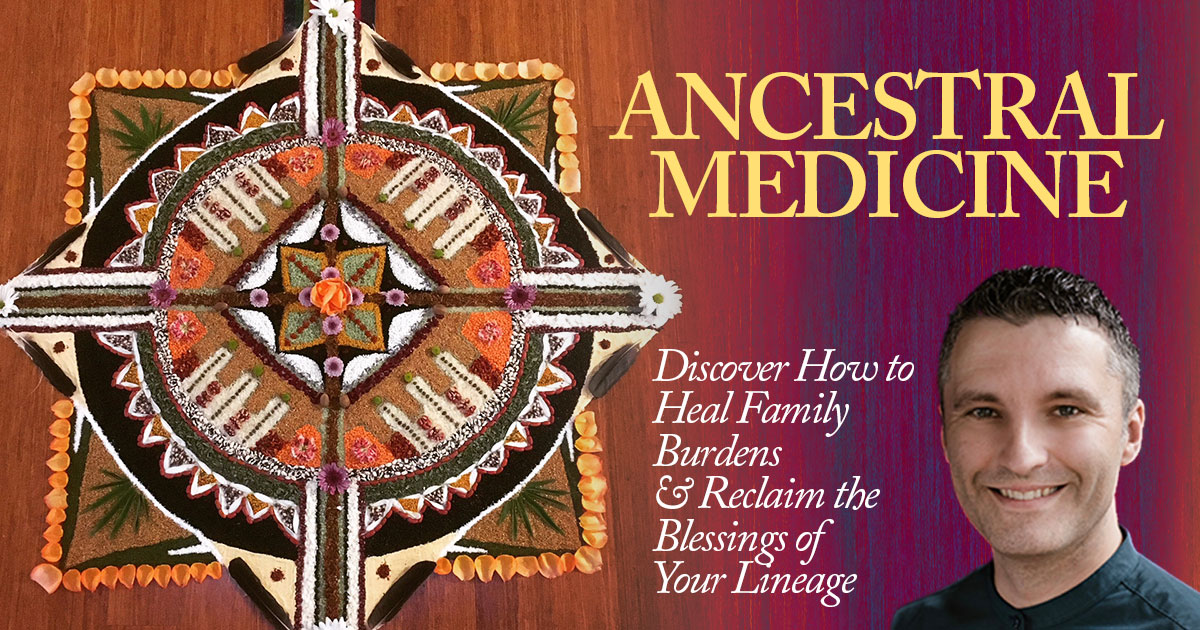
We now know that we can inherit more than just our blue eyes or male pattern baldness from our parents and ancestors. We can also inherit telomere length, happiness set point, and epigenetics. Biogenealogy shows what we term illness is actually a biological response and solution to a biological conflict. The seed of the conflict may have been planted in an ancestor’s life or earlier in our own life. For whatever reason, a resolution wasn’t available or possible. What if we can heal these ancestral wounds – with ancestral medicine? Rather than unknowingly trigger these conflicts within our own lives?
In Ancestral Medicine, Daniel Foor shares exercises, perspectives, and rituals about healing ancestral wounds that are very much present in the living descendants. His approach is to connect with the ancestors before the trauma and disruption occurred. These happy and spiritually vibrant ancestors can transform wound patterns, restoring vitality. The entire lineage then can reclaim and enjoy the family’s positive and luminous spirit.
Ancestral healing not only heals lineages. We are also able to release the pain and abuse on the collective level. Is this how we can heal society around the polarizing issues that have driven so many to war and hate? We now offer yoga to inmates or invite them to sweat lodges. Trauma Release Exercises to people in disaster and war zones. HeartMath for veterans and first responders. What if we also brought ancestral healing?
Who is Ancestral Medicine for?
Daniel Foor offers this work to anyone who is interested. You do not need to be trained in shamanism, mediumship, or psychopomp. There is no religious or spiritual tradition related to this work, as he presents it anyhow. The type and complexity of ancestral medicine rituals depend on each person’s intention, experience, and comfort level. This also includes how good someone’s boundaries are. Healthy boundaries are important when dealing with both incarnate and those not incarnate! Some situations, of course, call for those trained in such work, especially when dealing with the troubled dead.
As a Death Doula, I find this book offers an abundant fruit for thought. Even if his philosophies and his experience are outside your wheelhouse, these ideas, at any rate, can loosen any dogma and illusions we may have. He offers a lens to see life in a different light.
Daniel Foor devotes part of the book to death, dying, and last rites as well as the idea of multiple souls from a Mongolian shamanistic perceptive (which of course is not unique to this philosophy). I find having this knowledge can open up conversations with the dying and their family. Perhaps they come from this lineage or maybe they are looking for a wider perspective of the impending transition.
A doctor of psychology and a therapist, Daniel Foor himself has worked with a variety of Earth-honoring traditions including European Paganism, Mongolian Shamanism, Native North American traditions, and the Ifá/Òriṣà tradition of Yorùbá-speaking West Africa and the African diaspora. This diversity of knowledge and initiations in some cases have given him a way to make his work and offerings culturally inclusive. I think he would agree with Caroline Myss who has said “the soul has no religion.”
New to this idea of ancestral medicine and ancestor reverence? Here are three points he raises in his book that may help.
1) Ancestral medicine is about relationships, we all have ancestors, and relating to our ancestors is normal and was once part of traditional practices around the world.
2) He is also very clear about working with willing and vibrant ancestors. Because not all ancestors are willing, or able. Not all those ahead of us in the lineage are ancestors, yet. It can take some time and healing before the dead join the ranks of the ancestors.
Ancestors who embodied kindness and integrity during life can serve as sources and inspiration for living relatives. The loving dead can also work to guide, uplift, and protect their descents, whether or not the living fail is conscious of this support.
3) When the ancestors are not well, this can manifest as illness, addiction, poverty, and abuse. The destructive actions of recently dead moreover have ripples through the following generations.
Until the troubled dead are healed and join the loving ancestors, they can be influencing the living in unwanted ways. “The choice is not whether or not to be in relationship with them, but whether or not these relationships will be conscious and reciprocal.”
For those who are adopted, you may wonder how ancestral medicine works for you. Daniel Foor offers that the adoptive family and their ancestors have the same “psychological weight” as the biological one.
Blood ancestors are only one type of ancestors we can work with; others include spiritual, vocational, and other chosen families.
The first step to Ancestral Medicine Work
The first step is to research your ancestors as much as possible. For many people this is a challenge. More and more people have moved away from their ancestral lands. The traditional practice of ancestor reverence has also been disrupted.
Those we can name or remember by deed are the “remembered dead”. Even if we have little to no information, we can still connect in spirit. He reminds us that “genetic ancestors are no farther from you than your blood and bones.”
Daniel Foor also shares that as he did more ancestral medicine work, such as placing a tombstone for some unforgotten ancestors, his research opened up in incredible ways. As an act of reverence and remembrance, we invite our ancestors to speak with us in helpful and loving ways.
Like strands or filaments, our bloodlines consist of individual ancestors whose lives and spirits weave and combine to form sturdy fires. The intricate weave of these fibers in turn expresses the beautiful and elaborate cloth of the ancestors as a singular collective consciousness.
The quality of the raw materials and individual lives informs the integrity of the fibers, and by extension the quality of the overall garment. Each level of scale, every individual life, is inseparable from the whole.
Doing work with just one lineage can already release many blockages. You can choose to work with the line of women who came before your two grandmothers. Or perhaps you would like to start with the line of men who came before your two grandfathers.
Ancestral Medicine offers an easy way to visualize your blood lineage by seeing it as five basic spans.
- lineage before the ancestral guides (collective human ancestors 200,000 BC)
- lineage from the guides to the remembered dead
- remembered dead
- living family members
- yet-to-be-born descendants
In today’s world, many people are separate from their ancestral homes, cultures, and traditional practices for many reasons. As a result, many can feel isolated from the large fabric of their past. Daniel Foor writes that sometimes when we feel that we are the ones with the struggles, we can feel more shame and even more disconnected.
When we can understand them in the context of family patterns, we can feel greater compassion. This self-compassion can fuel our healing. It also puts into perspective the actions of family members, and humanize our parents who we can sometimes demand or at least desire to be infallible and unconditionally loving.
As more and more people move from their ancestral lands, it becomes even more important now to honour ancestors and place. Before you become a citizen of a new country, you usually have to pass a test about its history. What if we researched more deeply the history of where we live, where we call home? This includes the ecological history of the land.
Daniel Foor suggests discovering what the landscape was like 50, 100, or 500 years before. This information helps us be better guests and find friends and allies in the local spirits of the flora and fauna.
Since I last lived in Vancouver, we have become more sensitive and respectful about living on unceded territories of the Musqueam, Squamish, and Tsleil-Waututh. Not quite there, these efforts do help us bridge with the First Peoples and the ancestors of our beautiful lands. Our school curriculum sorely missed out on this important history and generally glossed over the effects of colonialism. Written for newcomers and new immigrants to Vancouver, this ebook may be a good introduction for those interested.
The land itself is a living, breathing convergence of many different elder powers, some of whom appear to modern ways of thinking as mountains, rivers, forests, stones, and so on. The ecological convergence of the biosphere is the dancing of the gods. Many cultures have traditionally maintained active, conscious relationships with these forces.
If we go far enough back, we find that you and I have common ancestors. People are now awakening to how trauma touches us and continues to reverberate through family lines. Here with Ancestral Medicine, Daniel Foor shows how powerful healing the lineage can be.


